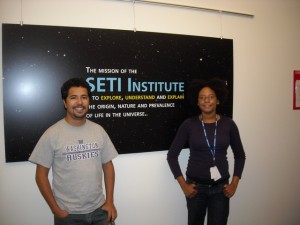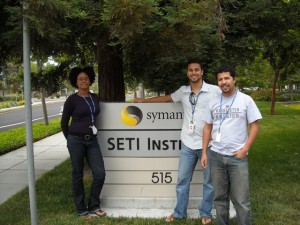Summer 2009 – new students and projects
The end of Kayuga in HD!
June 23, 2009International Space Station – some news.
June 27, 2009Hello,
In one of my first posts I described the group of students who were working with me. Since the end of the semester (beginning of June) my group has changed considerably. I am going to give you an update since I think it is important to acknowledge my students without whom my research could not be done.Brent Macomber who worked with me since September 2006 as a UC-Berkeley under-graduate student, left at the end of May 2009. Over these past 3 years, he has been involved in the study of binary asteroids. We published various results together and more are coming. His contributions to the development and management of the VOBAD database and the data analysis of photometric observations of asteroids have been significant. Unfortunately, he left UC-Berkeley to start a Master at Texas A&M University in the field of aerospace engineering. I wish him good luck for his future which I am certain will be remarkably successful.
I was hoping that Michelle Kislak, under-graduate student at UC-Berkeley, will take over Brent’s projects after working with him in spring 2009, unfortunately she also left recently to work with another group (supernovae people). She seems to enjoy this new team and the new management.
I am not yet “student-free” 🙂 Thru the Summer Research Experience for Undergraduates (REU) Program in Astrobiology at the SETI Institute, I hired Abigail Reiss, under-graduate student at San Francisco State University. Abigail will work 10 weeks at the SETI institute and will be involved in the observations and data analysis of low resolution spectra recorded with the 3m telescope at Lick Observatory. On June 16, we had one night of observations at the telescope and she will start soon processing the data using an code written by my colleague Josh Emery. To broaden this research experience, she will also use super-LOTIS, a 0.6m robotic telescope, to observe various asteroids and extract their light-curve (variation of brightness due to the irregular shape and spin of the asteroid).
Finally, I also hired a new lab assistant named Emilio J. Enriquez who is finalizing a master in astrophysics at the San Diego State University. Emilio will help me processing and analyzing the data collected in Feb 2009 using the VLT. I mentioned these new observations in my post written on March 11. “We requested time more than 1 year ago to observe (90) Antiope components spectroscopically using the Integral Field Unit SPIFFI mounted with the SINFONI Adaptive Optics system. In 2007, our group published an article and an ESO Press-release (PR) showing the orbit, shape and size (thus bulk density which indicates a rubble-pile interior) of this interesting and unique similarly-sized binary system. We conclude that most likely this double system formed by fission of a parent body, implying that the two components should have a similar composition. I hope these new comparative spectra of the two components will tell us more about this interesting possibility.” Interestingly, Emilio worked with me at UC-Berkeley during the summer 2004 as an CfAO summer program student where he developed a software to improve the data analysis of asteroid images taken with adaptive optics on 8-10m class telescopes. The VOBAD database, previously mentioned above and released a few weeks ago, contains part of his work. This new project is different for him since it links adaptive optics and spectroscopy. Hopefully, we will manage to finalize the analysis of these complicated data and write an article at the end of the summer.
It is going to be a very interesting summer, quite hectic but also more animated than the rest of the year. Since both students will be based at SETI Institute, I will spend significantly more time in the Silicon Valley.
I am attaching a few pictures that we took last week with Abigail and Emilio at SETI Institute.
cheers
F.




